China
People's Republic of China
| |
|---|---|
 Flag
 National Emblem
| |
Anthem: 义勇军进行曲 Yìyǒngjūn Jìnxíngqǔ ("March of the Volunteers") | |
 Land controlled by the People's Republic of China shown in dark green; land claimed but uncontrolled shown in light green. | |
| Capital | Beijing 39°55′N 116°23′E |
| Largest city | Shanghai |
| Official languages | Standard Chinese |
| Recognised regional languages |
|
| Official script | Simplified Chinese |
| Ethnic groups | Majority Han Chinese |
55 minorities
| |
| Religion (2020) |
|
|---|---|
| Demonym(s) | Chinese |
| Government | Unitary Marxist–Leninist one-party socialist republic |
• CCP General Secretary, President & Military Chairman | Xi Jinping |
• Premier | Li Keqiang |
• Congress Chairman | Li Zhanshu |
• CPPCC Chairman | Wang Yang |
• 1st CCP Secretariat's Member | Wang Huning |
• CCP Discipline Secretary | Zhao Leji |
• 1st Vice Premier | Han Zheng |
• Vice President | Wang Qishan |
• Supervisory Commission Director | Yang Xiaodu |
• Chief Justice | Zhou Qiang |
• Prosecutor-General | Zhang Jun |
| Legislature | National People's Congress |
| Formation | |
• First pre-imperial dynasty | c. 2070 BCE |
• First imperial dynasty | 221 BCE |
• Republic established | 1 January 1912 |
• Proclamation of the People's Republic | 1 October 1949 |
• First constitution | 20 September 1954 |
• Current constitution | 4 December 1982 |
• Most recent polity admitted | 20 December 1999 |
| Area | |
• Total | 9,596,961 km2 (3,705,407 sq mi) (3rd/4th) |
• Water (%) | 2.8 |
| Population | |
• 2020 census | |
• Density | 145/km2 (375.5/sq mi) (83rd) |
| GDP (PPP) | 2021 estimate |
• Total | |
• Per capita | |
| GDP (nominal) | 2021 estimate |
• Total | |
• Per capita | |
| Gini (2018) | high |
| HDI (2019) | high · 85th |
| Currency | Renminbi (元 / ¥) (CNY) |
| Time zone | UTC+8 (China Standard Time) |
| Date format |
|
| Driving side | right (mainland);
|
| Calling code | +86 (mainland);
|
| ISO 3166 code | CN |
| Internet TLD |
|
China (Chinese: 中国; pinyin: Zhōngguó; lit. 'Central State; Middle Kingdom'), officially the People's Republic of China (Chinese: 中华人民共和国; pinyin: Zhōnghuá Rénmín Gònghéguó; PRC), is a country in East Asia and unitary one-party socialist republic led by the Communist Party of China (CPC). It is the world's most populous country, with a population of more than 1.4 billion. China follows a single standard time offset of UTC+08:00 even though spanning five geographical time zones and borders 14 countries, the second most of any country in the world, after Russia. Covering an area of approximately 9.6 million square kilometers (3.7 million mi2), it is the world's third or fourth largest country. The country is officially divided into 23 provinces, five autonomous regions, and four direct-controlled municipalities of Beijing (the capital city), Tianjin, Shanghai (the largest city), and Chongqing, as well as two special administrative regions: Hong Kong and Macau.
China emerged as one of the world's first civilizations, in the fertile basin of the Yellow River in the North China Plain. China was one of the world's foremost economic powers for most of the two millennia from the 1st until the 19th century. For millennia, China's political system was based on absolute hereditary monarchies, or dynasties, beginning with the Xia dynasty in 21st century BCE. Since then, China has expanded, fractured, and re-unified numerous times. In the 3rd century BCE, the Qin reunited core China and established the first Chinese empire. The succeeding Han dynasty (206 BCE–220 CE) saw some of the most advanced technology at that time, including papermaking and the compass, along with agricultural and medical improvements. The invention of gunpowder and movable type in the Tang dynasty (618–907) and Northern Song Dynasty (960–1127) completed the Four Great Inventions. Tang culture spread widely in Asia, as the new Silk Route brought traders to as far as Mesopotamia and the Horn of Africa. The Qing Empire, China's last dynasty, which formed the territorial basis for modern China, suffered heavy losses to foreign imperialism. The Chinese monarchy collapsed in 1912 with the 1911 Revolution, when the Republic of China (ROC) replaced the Qing dynasty. China was invaded by the Empire of Japan during World War II. The Chinese Civil War resulted in a division of territory in 1949 when the Chinese Communist Party (CCP) led by Mao Zedong established the People's Republic of China on mainland China while the Kuomintang-led ROC government retreated to the island of Taiwan. Both the PRC and the ROC currently claim to be the sole legitimate government of China, resulting in an ongoing dispute even after the United Nations recognized the PRC as the government to represent China at all UN conferences in 1971.
China is nominally a unitary one-party socialist republic. The country is a permanent member of the United Nations Security Council and a founding member of several multilateral and regional cooperation organizations such as the Asian Infrastructure Investment Bank, the Silk Road Fund, the New Development Bank, the Shanghai Cooperation Organization, and the Regional Comprehensive Economic Partnership, and is a member of the BRICS, the G8+5, the G20, the APEC, and the East Asia Summit. It ranks among the lowest in international measurements of civil liberties, government transparency, freedom of the press, freedom of religion and ethnic minorities. Chinese authorities have been criticized by political dissidents and human rights activists for widespread human rights abuses, including political repression, mass censorship, mass surveillance of their citizens and violent suppression of protests.
After economic reforms in 1978, and its entry into the World Trade Organization in 2001, China's economy became the second-largest country by nominal GDP in 2010 and grew to the largest in the world by PPP in 2014. China is the world's fastest-growing major economy, the second-wealthiest nation in the world, and the world's largest manufacturer and exporter. The nation has the world's largest standing army—the People's Liberation Army—the second-largest defense budget, and is a recognized nuclear weapons state. China has been characterized as a potential superpower due to its large economy and powerful military.
- No. 1 Hotpot. Hot Pot. ...
- No. 2 Sichuan Pork. ...
- No. 3 Braised Pork Balls in Gravy. ...
- No. 4 Shrimp with Vermicelli and Garlic. ...
- No. 5 Dumplings. ...
- No. 6 Chow Mein. ...
- No. 7 Peking Roasted Duck. ...
- No. 8 Steamed Vermicelli Rolls.
30 fun facts about China
1) China is officially known as the People’s Republic of China.
2) As of September 2020, China is the most populated country in the world with over 1.4 billion people (1,439,323,776). This is based on Worldometer elaboration of the latest United Nations data.
3) Mandarin is not the only language in China. There are others such as Yue, Wu, Minbei, Minnan, Xiang, Gan and Hakka. Some regions in China also have their own dialects.
4) China is considered a “coconut culture”. Chinese people present a stony, formal exterior, but they are actually as warm and welcoming as other cultures. Close friendships and relationships in China are earned over time compared to Western countries.
5) Family members living in one home is a reflection of Chinese success. Elders are highly revered in China. Younger generations are also expected to take care of their aging family members. They even have an Elderly Rights Law!

Filial piety and respect for one’s elders is the highest virtue in China.
6) Majority of Chinese people remember wars fought at home. History is deeply embedded in their educational system that even their Gen Z population know Chinese history very well.
7) Fortune cookies did not originate in China (it was invented in San Francisco) and it is not a traditional Chinese custom. This is contrary to what many Westerners think.

8) Put all of China’s railway lines, it can loop around the earth two times!
9) Chinese New Year’s celebration lasts for 15 days! It’s the biggest holiday in China which is usually celebrated in January or February. New year in China is even more popular than Christmas. But here’s an even interesting fact: many countries in the world celebrate Chinese New Year as well.
10) In China, every year is named after one of the 12 Chinese zodiac animals: Rat, Ox, Tiger, Rabbit, Dragon, Snake, Horse, Goat, Monkey, Rooster, Dog, and Pig. 2020 is year of the Rat.
11. The Bailong Elevator in Wulingyuan area of Zhangjiajie, China can carry visitors up to 300 meters high on a cliff’s edge. This elevator is the world’s heaviest and highest outdoor elevator.

The Bailong Elevator in Wulingyuan area of Zhangjiajie, China.
12) China is a multi-religious country. Because of its large population, many world religions have adhered there. However, most Chinese usually practice Taoism, Confucianism, and Buddhism.
13) China, along with Italy, has the highest number of UNESCO sites in the world. Some of the most visited UNESCO sites in China include the: Forbidden City in Beijing, The Great Wall of China, Summer Palace in Beijing, and the Temple of Heaven in Beijing and the world-famous Terracotta Army.
14) Speaking of UNESCO sites in China, the Forbidden City in Beijing has 9,000 rooms all in all. It is one of the largest and oldest imperial palaces in the world.
16) Despite its huge size, China surprisingly only has one timezone. Everybody is using the official Beijing time.
17) Every single Panda living in the whole world belongs to China. That means if you see a Panda in your country, it is lent by China. In China, all Pandas can be found in Chengdu, Sichuan’s capital city.

Meet China’s national treasure, the giant pandas of Chengdu.
18) Pandas eat all day long. They take about 10 to 16 hours a day eating. Despite belonging to the bear family, they do not hibernate.
19) Chinese people are the biggest travel spenders in the world. They spend US $260 billion every year, twice the spending of American travelers.
20) Ancient Chinese medicine already discovered blood 2,000 years before European scientist William Harvey announced it in 1628.
21) Ice cream was discovered in China some 4,000 years ago. The Chinese people back then combined milk, rice mixture and snow to create the yummy dessert.

It is said that Kublai Khan, the founder of the Yuan dynasty (1271-1368) added preserves and jam to his favorite icy drink, creating the world’s first ice cream prototype. In order to keep the ice cream production process private, he issued a decree that no one except the royal family could make ice cream.
22) Chinese people avoid using or mentioning the number “4” as it is associated with death.
23) Nope, football (soccer) was not invented in Europe. The first recorded information about the sport was 2,200 years ago in China. Ancient Chinese people created the world’s first soccer ball made of leather. The ball was filled with feathers and hair and the sport was original called ‘Tsu’ Chu,’ which means ‘kicking ball.’
24) China builds a new skyscraper every five days. There is no country in the world that is growing as fast as China. In a year, China builds at least 73 new skyscrapers.
25) You will never eat the same food twice in China. Every region in the country has their own dishes, distinct flavours and cuisine. In addition, Chinese food is served almost always fresh.

Peking duck is a famous duck dish in China. It is very tasty!
26) Chopsticks were originally used for cooking and not eating.
27) Ketchup is known to be an American condiment, however, its origins are are anything but American. Ketchup comes from the Hokkien Chinese word, “kê-tsiap”, the name of a sauce derived from fermented fish.
28) Unlike brides across the world, Chinese brides wear red instead of white. Red is considered to be a lucky color in China.
29) The Terracota Army in Xi’an China took 37 years to build. It consists of 8,000 clay soldiers built to guard an Emperor’s tomb.

30) China is home to world-class universities. In the Times Higher Education World University Rankings released last Wednesday, 2nd September, 7 Chinese universities was included in the top 200 universities in the world. The Chinese universities are Tsinghua University, Peking University, Fudan University, University of Science and Technology of China, Zhejiang University, Shanghai Jiao Tong
University and Nanjing University.
top tourist place of china
1. The Great Wall of China
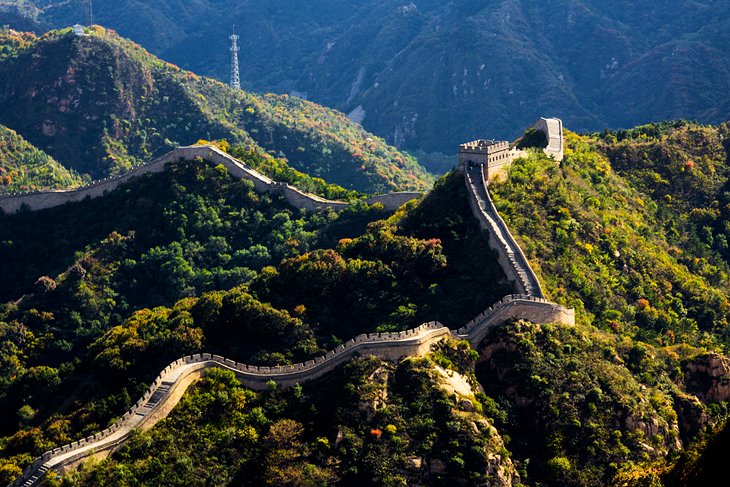
"Nobody can be a true hero unless he has been on the Great Wall" goes the popular Chinese saying, one that clearly demonstrates the importance placed upon this unique ancient monument.
The magnificent Great Wall of China - known in Chinese as 'Changcheng', or the 'Long Wall' - stretches more than 6,000 kilometers from the fortresses of Shanhaiguan in the east all the way to Jiayuguan in the west, passing through Hebei, Tientsin, Beijing - where the best preserved sections of the wall can be visited - Inner Mongolia, Ningxia, and Gansu.
Averaging six to eight meters in height but rising as high as 16 meters - and wide enough in places for five horses or 10 men to pass - the wall boasts numerous battlements and watchtowers. Some of the wall's oldest fortifications date back as far as the 7th century BC, with the best-known areas added around 210 BC when its various sections were joined together.
Today, the most visited section of the wall is near Badaling Pass northwest of Beijing, easily reached by public transport or organized tours. Other restored sections worth a visit include the section near Gubeikou, 130 kilometers from Beijing; and in Mutianyu, just 70 kilometers northeast of Beijing.
Location: Huairou District, China
2. The Forbidden City & the Imperial Palace, Beijing
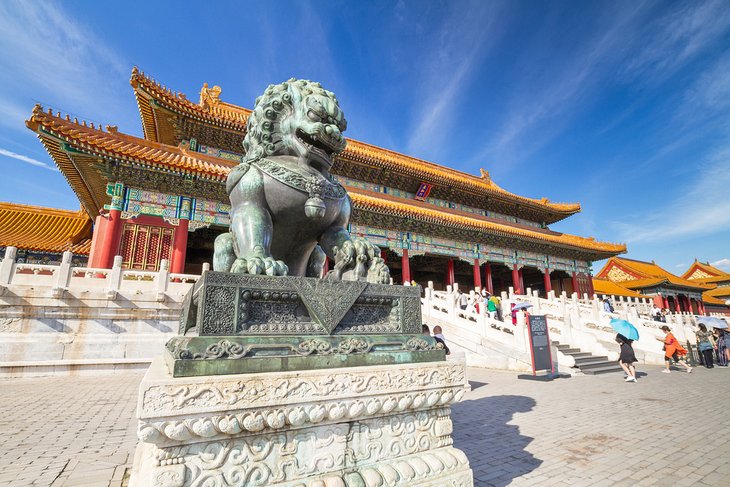
China's largest and most important building, the Forbidden City (Zǐjìnchéng) - also known as the Imperial Palace - is situated in the very heart of Beijing and is a must-see when visiting the country. Started during the Yuan Dynasty between 1271-1368, much of the complex seen today was built between 1406 and 1420. Really many splendid palaces in one, this sprawlinng complex was the residence of 24 Ming and Qing Emperors, whose presence forbade the entry of anyone other than the imperial family and their courtesans.
Covering some 720,000 square meters and protected by a 10-meter-high wall with watchtowers and a wide moat, this massive complex consists of areas set aside for ceremonial and administrative purposes, as well as a private residence used by the emperor. While it can take many hours to see everything, highlights include the five white marble Golden River Bridges; the Hall of Supreme Harmony, a 35-meter-tall building housing the imperial throne; and the exquisite emperor's banquet hall (the Hall of Preserving Harmony); and the Palace Museum with its large collection of art and artifacts from the Ming and Qing dynasties (English language museum tours are available).
Other important attractions in the vicinity of the Imperial Palace include famous Tiananmen Square, and the Temple of Heaven, one of the country's most important religious sites, which dates back to the 15th century.
Address: 4 Jingshan Front St, Dongcheng, Beijing, China
3. The Terracotta Army, Xi'an
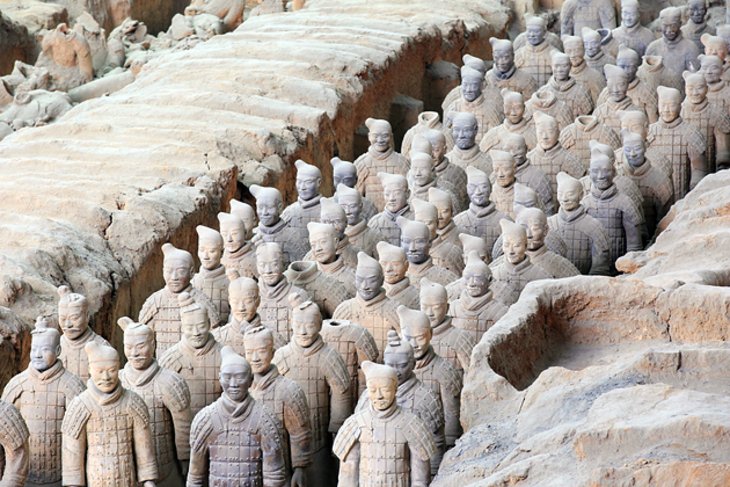
It was while digging wells on the outskirts of Xi'an in the 1970s that farmers stumbled across what was to be China's most important archeological find: the Terracotta Army. Distributed over three large underground pits and built to guard the First Emperor's tomb, the find included more than 8,000 life-size warriors, some 520 horses, and more than 100 chariots, along with numerous other non-military characters dating from around 280 BC.
Although some were severely damaged due to the passing of time, many of the statues unearthed have been painstakingly re-assembled and stand as testament to the importance bestowed upon the emperor and the afterlife. The site - part of the Emperor Qin Shi Huang's Mausoleum Site Park - is one of China's most important tourist destinations and offers the unforgettable experience of standing in front of this assembly of soldiers and horses as if inspecting a centuries-old parade. English language guided tours are available.
Address: Lintong District, Xi'an, Shaanxi, China
4. The Summer Palace, Beijing
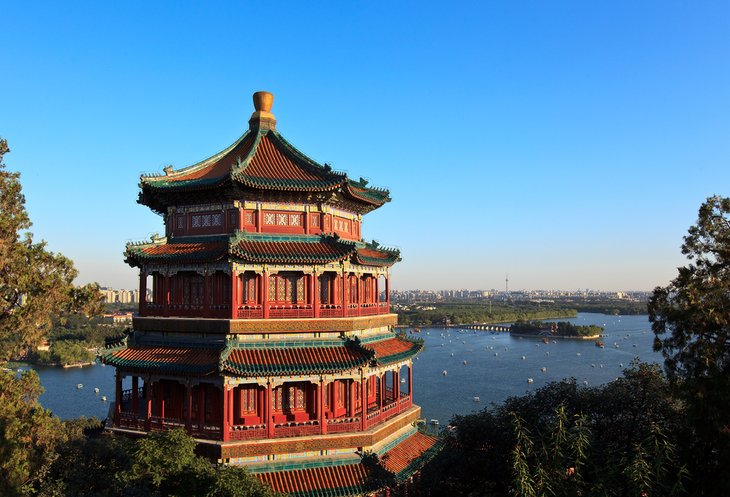
An easy 15-kilometer commute from Beijing, the sumptuous Imperial Summer Palace (Yíhé Yuán) is set amid more than 700 acres of beautiful parkland and is one of China's most visited attractions. While the palace itself was built in 1153, its large lake was added in the 14th century to enhance the Imperial Gardens.
Highlights include the magnificent Hall of Benevolence and Longevity (Renshou Dian), with its throne; and the beautiful Great Theatre, a private three-story structure built in 1891 to satisfy the imperial family's love of opera. This historic venue is still used for performances of traditional Chinese plays and musical events, and is worth a visit for a performance or show.
Other highlights include the Hall of Happiness and Longevity (Le Shou Tang Hall), with its lovely gardens and courtyards, as well as many miles of picturesque pathways and walking trails. If time allows, try to also take in the ruins of the Old Summer Palace, said to have once been one of the country's most elaborate and architecturally attractive palaces. Sadly, this once impressive structure was destroyed by colonial forces in the mid-1800s.
Address: 19 Xinjiangongmen Rd, Haidian District, China
5. Cruising the Li River, Guilin
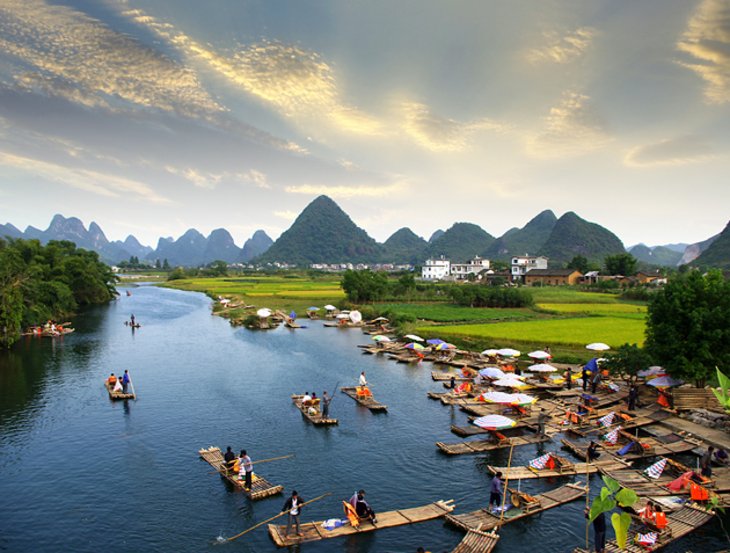
The town of Guilin, in the northeast corner of Guangxi, boasts some of China's most beautiful countryside and is famous for the Li River, which meanders through the town and surrounding karst mountains. While for hundreds of years this unique scenery has attracted poets and artists and has been the subject of countless fairy tales and legends, these days, it's popular with tourists from around the world wanting to see this natural splendor up close.
The best way to enjoy the area is to take a cruise along the Li River. The most popular stretch is from Guilin to Yangshuo, where the river meanders peacefully through some 80 kilometers of remarkable rock formations and caves with romantic names such as the Mount of Unique Beauty, Elephant Trunk Hill, and Reed Flute Cave. Depending upon the type of boat used - you can choose from a tourist cruise ship to small bamboo punts - trips can take anywhere from a few hours to multiple days.
6. Chengdu Research Base of Giant Panda Breeding, Sichuan
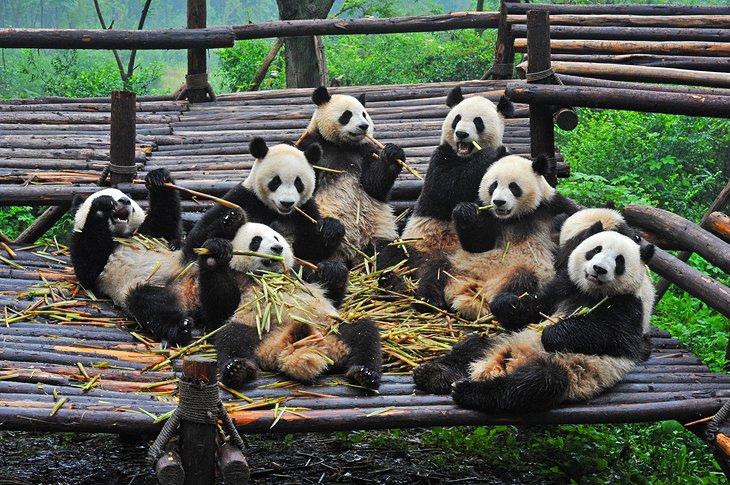
No visit to China would be complete without at least one panda experience. While the country's top zoos boast many fine specimens of these fascinating creatures, the best place to see them in a close approximation to their natural habitat is at the excellent Research Base of Giant Panda Breeding in Chengdu, located in the province of Sichuan. Here, you'll have the chance to watch as many as 80 pandas go about their daily routines, from foraging to playing in the facility's large park-like setting.
In addition to viewing these splendid animals up close, you'll learn a great deal about them from the many permanent exhibits and displays detailing ongoing conservation efforts to safeguard their future.
If possible, try to time your visit for the morning feeding sessions when the pandas are at their most active. Better still, sign-up for one of the unique experiential volunteer programs that will have you involved in the feeding and care of these cuddly creatures - and possibly even holding a baby panda. English language tours are available.
Address: 1375 Xiongmao Ave, Chenghua District, Chengdu, Sichuan, China
7. The Yangtze River and the Three Gorges
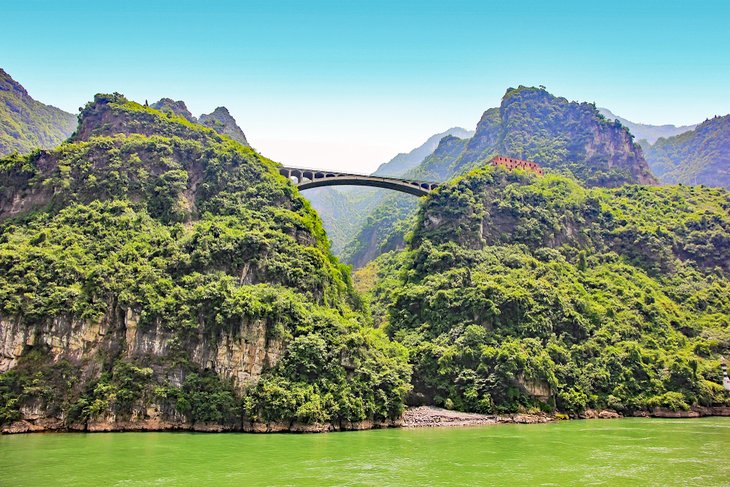
Known in China as Chang Jiang ("Long River"), the mighty Yangtze River extends more than 6,000 kilometers, making it the longest and most important river in China and the third longest in the world after the Amazon and the Nile.
Flowing from Tibet in the west to Shanghai in the east through eight provinces, the Yangtze has, for more than 2,000 years, been China's major transportation route (some 2,700 kilometers are navigable). Its vast catchment area, with its 700 tributaries, cover about one-fifth of the total area of the country and encompass a quarter of the country's agricultural land.
While its immense length ensures the river can be visited at numerous points in China, by far the most popular for tourists is the beautiful Three Gorges - Qutang, Wu, and Xiling - a 200-kilometer stretch between the towns of Fengjie and Yichang. In places a mix of raging torrents and dangerous shallows, here the river winds its way through the gorges and their rugged cliffs and high mountain peaks in a stretch of scenery as dramatic as the Grand Canyon.
Numerous sightseeing options are available, from luxurious riverboat cruises focusing on the region's many historical attractions and places of scenic beauty to challenging adventure tours along the most dramatic sections of the river.
8. The Classical Gardens of Suzhou, Jiangsu
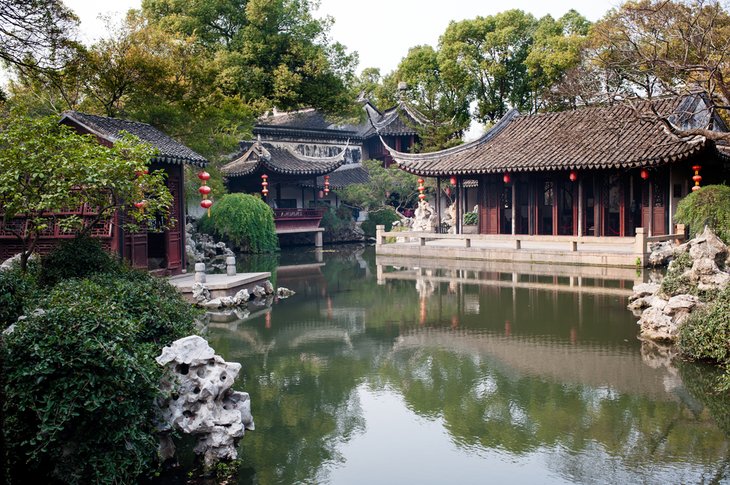
Considered one of the world's most important historic gardens - hence their designation as a UNESCO World Heritage Site - the Classical Gardens of Suzhou should rank highly on your China travel itinerary. Located in the historic city of Suzhou in Jiangsu province, these magnificent gardens were established in the 11th century, at a time when the city was experiencing unprecedented growth, and were among some 270 or more gardens planted here.
Of the surviving restored gardens, the most famous is the delightful Garden of Lingering, a seven-acre site laid out in 1800 on the site of a park originally created during the Ming Dynasty. One of the most famous garden complexes in China, the garden boasts a pool, several attractive buildings, a man-made hill, a grove of peach trees, and a lovely covered pathway on the walls of which hang more than three hundred stone tablets engraved with old Chinese characters.
Also worth visiting is the Garden of the Cang Lang Ting Pavilion, a two-acre garden offering many unique features, including a double arcade connecting the inner and outer sections.
Address: 178 Dongbei St, Gusu District, Suzhou, Jiangsu, China
9. The Potala Palace, Tibet
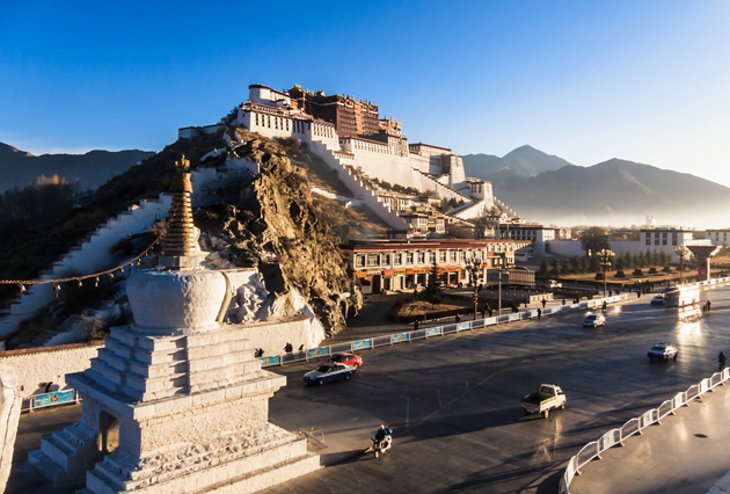
Another of China's most recognizable historic structures is the magnificent Potala Palace in the town of Lhasa, Tibet. Constructed as a fortress and residence for the Dalai Lama, it was for centuries a center of political and religious power and contains many of the religion's most important treasures.
The first of the two Potala Palaces, the Red Palace, was built in the 17th century and contains the complex's most important shrines. These are found in the Enthronement Hall, the walls of which are covered with murals depicting scenes from the lives of the Dalai Lamas and the Tibetan kings. Other highlights of the Red Palace are its many vast halls devoted to the religion's teachings, and the elaborate tombs (known as "stupas") of a number of Dalai Lamas.
The equally impressive White Palace was completed in 1648 and includes the sleeping quarters, studies, and reception rooms, most untouched since 1959 when the Dalai Lama fled Tibet. While in Lhasa, be sure to visit the superb Jewel Gardens. Part of the Dalai Lama's summer residence, these 90-acre gardens were first started in the 1840s and encompass everything from grand palaces and pavilions to pleasant lakes.
Address: 35 Central Beijing Road, Lhasa, Tibet, China
10. Shanghai's Promenade: The Bund
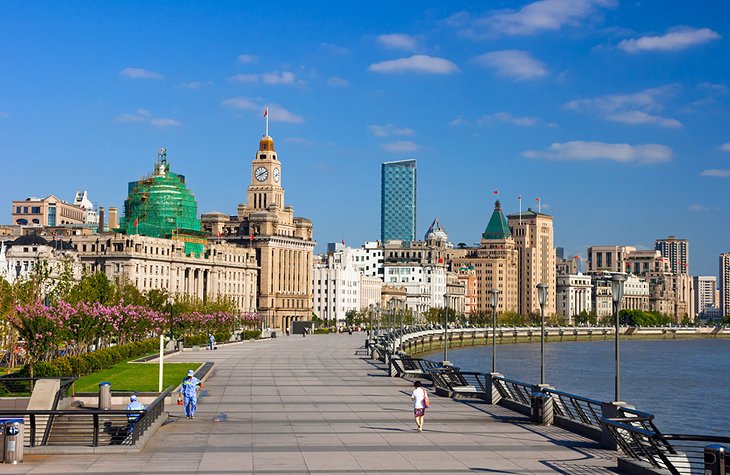
A remarkable act of smart city planning and preservation can be seen in Shanghai's splendid riverside promenade, the Zhongshan Lu, perhaps better known as the Bund (Wàitan). As you stroll this wide pedestrian zone along the Huangpu Jiang River, you'll almost forget you're bang-smack in the middle of China's largest city (Shanghai's population exceeds 24 million people).
Famous for its European feel, a fact owed to the district's past as the location of the city's International Settlement, the Bund is popular for its 52 preserved English- and French-influenced buildings, many now restaurants, cafés, stores, and art galleries. Representing a variety of influences from Gothic to Renaissance styles - including a number of Art Deco buildings - the architecture includes highlights such as the old harbor customs office, with its bell tower, and the majestic Peace Hotel.
For the best views of the Bund, visit the 468-meter Oriental Pearl Tower on the opposite bank of the Huangpu Jiang River. If time allows, be sure to also visit the Yu Garden. Known affectionately as the "Garden of Happiness," this must-see garden can trace its roots back to 1559 when it was laid out. Many of the original structures survive to this day.
Address: Zhongshan East 1st Rd, Wai Tan, Huangpu, Shanghai, China
11. Hangzhou's Historic West Lake
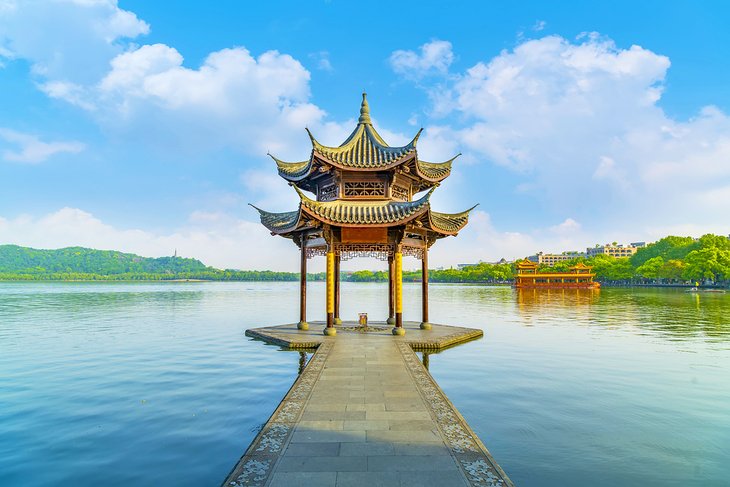
Few cities in China can boast quite the same concentration of splendid historic sites and ancient temples as the city of Hangzhou (Hangchow). Capital of Zhejiang province and located at the southernmost end of China's famous Grand Canal, much of this rich collection is gathered around lovely West Lake, a six-kilometer-square stretch of water in the heart of the old city, which is surrounded by numerous hills, pagodas, and temples.
Divided into five distinct sections by man-made causeways dating back as far as the 11th century, it's a marvelous area to explore on foot as you cross from one stretch of water to the next, only to be met with another cluster of fine old buildings. It's particularly pleasant in spring when its many peach trees are blossoming.
Part of the fun is lingering on the lake's many fine old bridges, one of the best being the Broken Bridge (Duanqiao) linking the Baidi Causeway with the shore, and exploring Little Paradise Island with its four mini-lakes linked by the zigzagging Bridge of the Nine Arches.
Be sure to hop aboard one of the many tour boats and small pleasure craft available to whisk you around the lake. And if time permits, stick around for the fun musical fountain show held each evening.
12. The Mausoleum of Light: The Northern Imperial Tomb, Shenyang
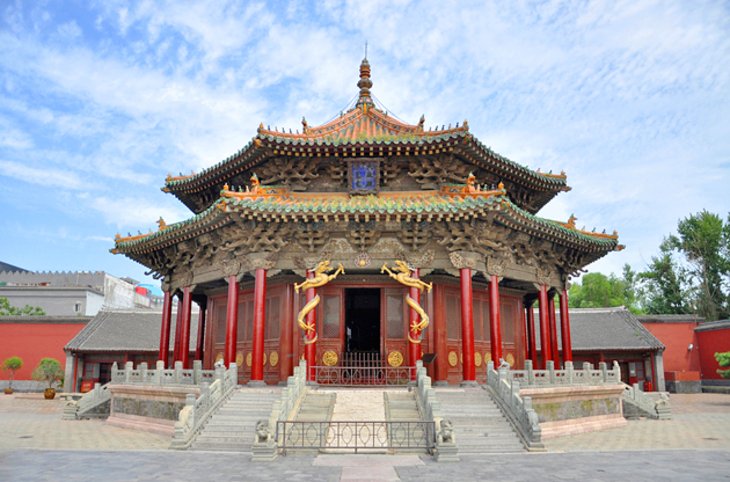
In China's mountainous northeastern region is the old city of Shenyang. This important center for trade and culture is home to the Mausoleum of Light (Zhaoling), also known as the Northern Imperial Tomb. One of northeastern China's most important historic sites - it's included on the UNESCO World Heritage Site's list of Imperial Tombs of the Ming and Qing Dynasties - the tomb is noted for its unique architectural style: a combination of traditionally arranged Chinese burial sites and castle-like buildings of the early Qing period.
Buried here in a vast site covering more than 180,000 square meters that took eight years to complete is Emperor Huang Taiji, who reigned from 1626-35. The site is notable for its 'Path of Souls', a laneway lined with stone columns and sculptures of the emperor's favorite horses.
Another important site is the imposing Imperial Palace dating from the early Qing era, the second largest completely preserved palace complex in China after the Imperial Palace in Beijing. The complex served as a residence for the first Qing Emperors and includes several splendid courtyards around which are grouped numerous buildings, including the Hall of Exalted Government (Chongzheng Dian) housing the imperial throne.
Location: Huanggu District, Shenyang, China
13. Leshan Giant Buddha, Sichuan
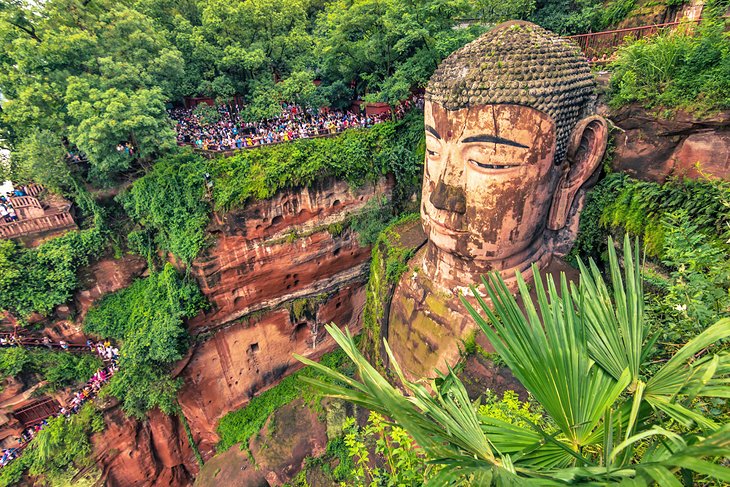
"The mountain is a Buddha and the Buddha is a mountain." So goes the famous Chinese saying, one that's attributed to the spectacular 71-meter-tall Leshan Giant Buddha. And it certainly makes sense as you stand at its feet as the colossal statue towers high above you.
Started in AD 713 by a Buddhist monk and completed 90 years later, this important religious icon is carved entirely from a stone cliff-face and is the largest Buddha sculpture in the world. Representing the Buddha Maitreya, the statue is even more dramatic given its location overlooking the river that it was designed to appease (it had often proven treacherous for shipping).
Designated a UNESCO World Heritage Site, the Giant Buddha continues to draw huge numbers of pilgrims from across the globe and is widely regarded as one of China's must-visit attractions. Easily accessible from the city of Chengdu, the Leshan Giant Buddha can be reached by a fun ferry trip from the public docks in Leshan. The scenic park in which the Buddha is set is also worth exploring, so be sure to allocate sufficient time in your itinerary.
Address: 2345 Lingyun Rd, Shizhong District, Leshan, Leshan, Sichuan, China
14. The Hong Kong Skyline
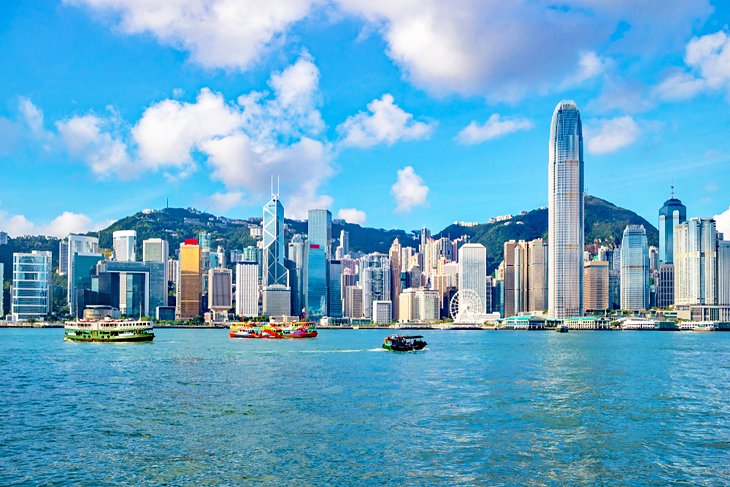
Widely considered one of the world's most dramatic city skylines - as much a result of its having one of the highest concentrations of skyscrapers as it is the presence of the tall hills that frame them - Hong Kong has for decades been the bustling capital of finance and commerce in this part of the Pacific. And it's a cityscape that can be enjoyed from a number of different vantages.
One of the best views is from Victoria Peak on Hong Kong Island, where the skyscrapers frame the city's huge harbor, a special treat after nightfall. Equally stunning is the view from Victoria Harbour itself. Here, you can hop aboard one of Hong Kong's famous ferries and head to various points to wander and explore, such as Kowloon. Or you can simply stay on board and enjoy the views.
If possible, try to time your trip to coincide with the nightly laser extravaganza, a stunning 360-degree laser-light show that uses the harbor's skyscrapers as a magical backdrop. For the best views, try to catch the show from the Kowloon side of Victoria Harbour.
15. Zhangjiajie National Forest Park, Hunan
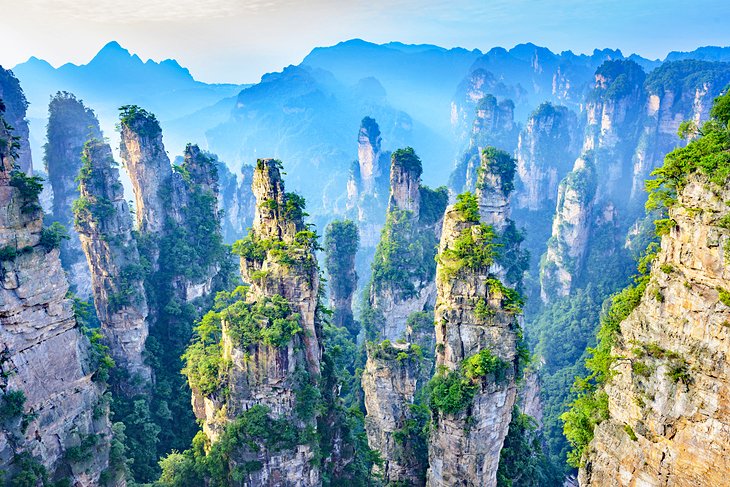
When you first set eyes on Zhangjiajie National Forest Park in Hunan province, it's certainly not difficult to see how filmmaker James Cameron was able to draw inspiration from it. Cameron's box office hit, Avatar, could well have been set in this area of stunning natural beauty, its many unique pillar-like rock formations looking like some incredible alien landscape right out of a sci-fi movie. One of the tallest pillars, standing at an impressive 1,080-meters, has been renamed "Avatar Hallelujah Mountain."
This is one of the lesser known places to visit in China, but it's well worth the effort to get here. In addition to its many natural wonders, which can best be explored as part of an organized tour, the park boasts a number of new man-made attractions. The first to be built was the Bailong Elevator, aka the "Hundred Dragons Sky Lift." Elevating groups of up to 50 people 326 meters skyward in under two minutes, it's an impressive structure, and one that offers dramatic views all the way.
Also notable is the Zhangjiajie Grand Canyon Glass Bridge. Opened in 2016, it's heralded as the world's highest and tallest pedestrian bridge. Standing 300 meters above the ground and extending 430 meters along a spectacular cliff face, it's an attraction that's definitely not recommended for the faint of heart but one of the best things to do if you are looking to add a little adventure to your day.
Location: Wulingyuan District, Zhangjiajie, Hunan, China

